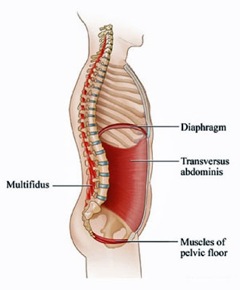So you’ve recognized that your niggling pain is too persistent to be ignored. You’ve done some stretching to tease out the knots and tight spots and you’re feeling much better. Maybe you’ve been for a massage or taken my advice and been to visit a health professional who’s been able to give you a diagnosis (which probably included some advice to improve your core strength).
But you’re a Tradie! You perform physical work every day. You are strong! Aren’t you?
Whatever the case it’s time to start thinking about prevention and understanding core muscles.
First of all we need to dispel a few myths. Core has become a fitness buzzword in recent years. People seem to think core training is synonymous with abdominal training. Most people think of the core as six-pack toned abs but the truth is that the abdominal muscles are a very small part of the core. The abs have very limited and specific action, and what experts refer to as the “core” actually consists of many different muscles that stabilize the spine and pelvis, and run the entire length of the torso.

The main muscles involved include the transverse abdominis, rectus abdominis, internal and external obliques, the quadratus lumborum, multifidus, erector spinae, glutes, hip flexors, pelvic floor and the diaphragm. The diaphragm is the main muscle of breathing in the human body and so breathing is important in providing the necessary core stability for moving and lifting. So basically it’s the front, back, top, bottom and inner muscles of the entire torso.
Any core conditioning exercise program needs to target all these muscle groups to be effective.
It is the action of these muscles contracting together upon the incompressible contents of the abdominal cavity (i.e. the internal organs) that provides support to the spine, pelvis and shoulder girdle and creates a solid base of support. When this happens, we are able to generate powerful movements of the extremities (arms and legs).
Core muscles are essential for the maintenance of an upright posture. They control walking and movement in any direction, transfer energy and shift body weight. A strong core distributes the stresses of weight-bearing and protects the spine from unnecessary shifting and shearing of vertebral structures. Insufficient core stability means the lower back is not supported from the inside resulting in strain, lower back pain, poor posture and lethargy.
Whenever a person moves, to lift something or simply to move from one position to another, the core region is tensed first. This tension is usually made unconsciously and in conjunction with a change in breathing pattern. No matter where motion starts, it ripples upward and downward to adjoining links of the chain. Thus any weak or inflexible core muscle can impair how well your arms and legs function. And that saps power from many of the moves you make.
Properly building up your core cranks up the power. A strong core also enhances balance and stability. Thus, it can help prevent falls and injuries at work, during sports or other activities. In fact, a strong, flexible core underpins almost everything you do.
Core strength is achievable through many bodyweight exercises and can be done easily at home. One of the most popular of these is “The Plank” however, there are a few instances where you should avoid this pose entirely ie. if you have a history of carpal tunnel syndrome or if you have a history of degenerative low back problems.

So it’s always wise to consult your doctor before undertaking any exercise program and locate a qualified and accredited Fitness Professional to teach you correct technique before attempting any exercise on your own.
Next week I am going to discuss the importance of Nutrition for Optimal Health and Strength.
